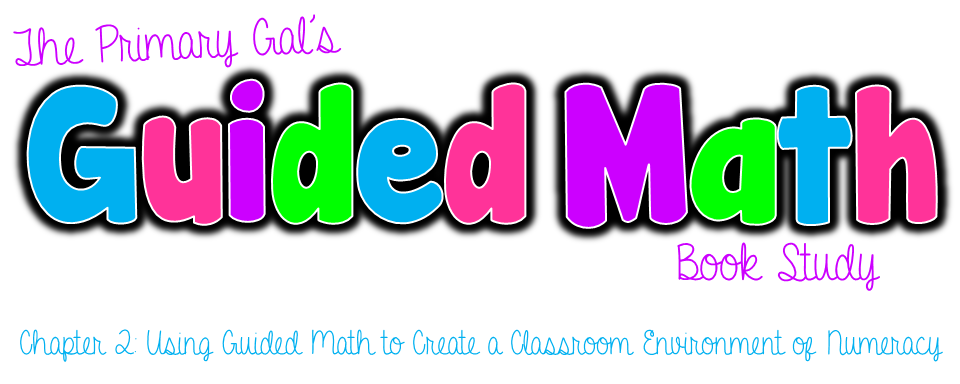In Chapter 2 the comparison; or rather, contrast is made between Guided Reading and Math. In Reading it has become a MUST to have print EVERYWHERE! Letters and words that are both familiar and challenging to our students are found all around the room. It has become second nature. But sadly, this is not the case in math. I know this to be true for myself! I don't have a math word wall. I don't make sure there are math problems around the room to read. I don't have a math library. I don't have a math "word work" station. I did not give the same focus and intentionality to setting up my math time that I gave to my Daily 5 expectations. And when my students were loud, off task, and crazy it was MY fault!! Did you hear that.....it was NOT them it was ME!! (gasp!!) I actually sat down (and it was probably after reading this chapter earlier in the year :) and apologized to my class that we have not been giving the same structure and modeling to our math as we did to our Daily 5.... and so we did!! No things were not perfect...but they were MUCH better!!
In a nutshell: Foundational Principles for Guided Math-
- all children CAN learn
- numeray-rich environment promotes mathematical learning for students
- learning is a social process
- learning math is a constructive process
- organized classroom supports the learning
- modeling, think alouds, and opportunities for problem solving and purposeful conversations
- children are responsible for their learning
So what do you need for a numeracy rich classroom?? Well, if your already doing guided reading (notice a theme??) then just about the same things!!
- calendar
- word wall/vocabulary display
- manipulatives
- PoD
- math journals
- graphic organizers
- class made charts
- math related literature
- books made by students
For me the MOST important principals are: all children can learn, learning is a social process, organized classroom supports the learning, modeling, think-alouds, and opportunities for problem solving and purposeful conversations. I have made a conscious effort from day one to NOT focus on "the answer". I have stressed "the why" and "how" of the problem. I have also made it a point to emphasize there is more than one way to solve a problem and I am not always right! It is OK to make mistakes. I do feel that Wholebrain Teaching has really helped out with the math wall and helping students to learn how to communicate to the class and each other their thinking. WBT has what are called "Power Pix" it is a type of anchor chart for a specific skill. Then when students have "mastered" the term they go on the "Power Pix wall" to be used for review, games, or attention getters during the year. (Sorry I will post pics later... I can't seem to find them!) But here is the link to my freebies..
http://www.teacherspayteachers.com/Product/2nd-Grade-Power-Pixs-Math-806555
http://www.teacherspayteachers.com/Product/Power-Pix-wall-label-pencil-labels-815473
http://www.teacherspayteachers.com/Product/2nd-Grade-Power-Pixs-Math-806555
http://www.teacherspayteachers.com/Product/Power-Pix-wall-label-pencil-labels-815473
Also, the "Teach/OK" really helps the students in becoming engaged, active communicators with others.
What I want to do MORE of:
- interactive journals-AND get my students to go there 1st!
- charts
- math writing
- math literature & student made math lit.
- use of graphic organizers-I never thought to use a Venn to compare addition and multi.!!
I do! And mostly because of what I mentions earlier! I really focused not they "why", I tried to get at least 3 different ways to solve a problem, and I expected my students to answer in complete sentences.... You would be surprised how that really got them thinking!
a Rafflecopter giveaway





No comments:
Post a Comment